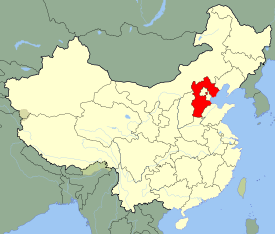Shijiazhuang
| Shijiazhuang 石家庄 |
|||||||||
|---|---|---|---|---|---|---|---|---|---|
| — Prefecture-level city — | |||||||||
| 石家庄市 | |||||||||
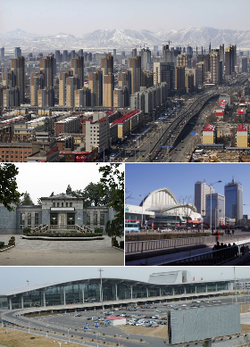 |
|||||||||
.png) |
|||||||||
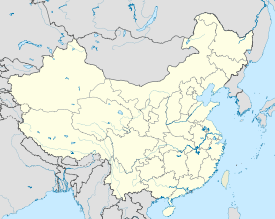 Shijiazhuang
|
|||||||||
| Coordinates: | |||||||||
| Country | China | ||||||||
| Province | Hebei | ||||||||
| City seat | Chang'an | ||||||||
| Government | |||||||||
| - Party Secretary | Che Jun (车俊) | ||||||||
| - Mayor | Ai Wenli (艾文礼) | ||||||||
| Area | |||||||||
| - Prefecture-level city | 15,848 km2 (6,118.9 sq mi) | ||||||||
| - Urban | 455 km2 (175.7 sq mi) | ||||||||
| Elevation | 83 m (272 ft) | ||||||||
| Population (2008) | |||||||||
| - Prefecture-level city | 9,600,000 | ||||||||
| - Density | 605.8/km2 (1,568.9/sq mi) | ||||||||
| - Urban | 2,600,000 | ||||||||
| - Urban density | 5,714.3/km2 (14,799.9/sq mi) | ||||||||
| Time zone | UTC + 8, H (UTC+8) | ||||||||
| Postal code | 050000 | ||||||||
| License Plate Prefix | 冀A | ||||||||
| Website | http://www.sjz.gov.cn/ | ||||||||
|
|||||||||
| Shijiazhuang | |||||||||||||||
|---|---|---|---|---|---|---|---|---|---|---|---|---|---|---|---|
| Traditional Chinese | 石家莊 | ||||||||||||||
| Simplified Chinese | 石家庄 | ||||||||||||||
| Hanyu Pinyin | Shíjiāzhuāng | ||||||||||||||
| Literal meaning | The Stones' Village | ||||||||||||||
|
|||||||||||||||
Shijiazhuang (simplified Chinese: 石家庄; pinyin: Shíjiāzhuāng) is a prefecture-level city and the capital of Hebei province, China. It is about 280 km (170 mi) south of Beijing. Shijiazhuang contains the Shijiazhuang metropolitan area, the Jingxing Mining District, five county-level cities, and twelve counties.
Shijiazhuang is a newly industrialized city. It experienced dramatic growth after the founding of the People's Republic of China in 1949. The population of the urban core has more than quadrupled in only 30 years[1] It is a central hub of transportation routes.
Shijiazhuang is home to large garrison of military troops in case of need to protect Beijing[1] It has a number of PLA colleges and universities.
Contents |
History
In pre-Han times (i.e., before 206 BC) it was the site of the city of Shihi in the state of Zhao, and, from Han (206 BC–AD 220) to Sui (581–618) times, it was the site of a county town with the same name. With the reorganization of local government in the early period of the Tang dynasty (618–907), the county was abolished. Shijiazhuang then became little more than a local market town, subordinated to the flourishing city of Zhengding (modern Zhengding) a few miles to the north.
The growth of Shijiazhuang into one of China's major cities began in 1905, when the Beijing–Wuhan (Hankou) railway reached the area, stimulating much new trade and encouraging local farmers to grow cash crops. Two years later the town became the junction for the new Shitai line, running from Shijiazhuang to Taiyuan in central Shanxi province. This connection immediately transformed the town from a local collecting center and market into a communications center of national importance on the main route from Beijing and Tianjin to Shanxi and — later, when the railway from Taiyuan was extended to the southwest — to Shaanxi province as well. The city also became the center of an extensive road network.
During the pre-World War II period, Shijiazhuang was a large railway town as well as a commercial and collecting center for Shanxi and the regions farther west and for the agricultural produce of the North China Plain, particularly for grain, tobacco, and cotton. By 1935 it had far outstripped Zhengding as an economic center. At the end of World War II the character of the city changed once again. Not only did it assume an administrative role as the preeminent city in western Hebei but it also developed into an industrial city. Some industry, such as match manufacturing, tobacco processing, and glassmaking, had already been established before the war.
Xibaipo, a village about 90 km from Shijiazhuang, in Pingshan County was the location of the Central Committee of the Communist Party of China and the headquarters of the People's Liberation Army during the decisive stages of the Chinese Civil War between May 26, 1948 and March 23, 1949, at which point they were moved to Beijing. Today, the area houses a memorial site.[2]
Only after 1949, however, did the planned industrialization of the city gather momentum. Its population more than tripled in the decade 1948–58. In the 1950s the city experienced a major expansion in the textile industry, with large-scale cotton spinning, weaving, printing, and dyeing works. In addition, there are various plants processing local farm produce. In the 1960s it was also the site of a new chemical industry, with plants producing fertilizer and caustic soda. Shijiazhuang also became an engineering base, with a tractor-accessory plant. There are important coal deposits at Jingxing and Huailu, now named Luquan, a few miles to the west in the foothills of the Taihang Mountains, which provide fuel for a thermal-generating plant supplying power to local industries. The city's role as a transport center has been supplemented by the construction of an airport handling regular domestic flights.
Geography
| Shijiazhuang | ||||||||||||||||||||||||||||||||||||||||||||||||||||||||||||
|---|---|---|---|---|---|---|---|---|---|---|---|---|---|---|---|---|---|---|---|---|---|---|---|---|---|---|---|---|---|---|---|---|---|---|---|---|---|---|---|---|---|---|---|---|---|---|---|---|---|---|---|---|---|---|---|---|---|---|---|---|
| Climate chart () | ||||||||||||||||||||||||||||||||||||||||||||||||||||||||||||
|
||||||||||||||||||||||||||||||||||||||||||||||||||||||||||||
|
||||||||||||||||||||||||||||||||||||||||||||||||||||||||||||
Shijiazhuang stands on the edge of the North China Plain at the foot of the Taihang Mountains, which lie to the west. The city stands south of the Hutuo River.
Climate
Shijiazhuang, though not located on the Mongolian steppe, has a steppe climate (Koppen BSk), because its annual mean temperature is 13.9 °C (57.0 °F), and there is an average of 517 millimetres (20.4 in) of annual precipitation. The area's winters are dry and somewhat cold, due to the influence of the Siberian anticyclone: January averages −1.5 °C (29.3 °F). With a July mean of 27.1 °C (80.8 °F), summers are very hot and humid, due to the influence of the East Asian monsoon; it is for the same reason that the majority of annual precipitation falls during those months, further explaining why the city features a semiarid climate.
| Climate data for Shijiazhuang (1971-2000) | |||||||||||||
|---|---|---|---|---|---|---|---|---|---|---|---|---|---|
| Month | Jan | Feb | Mar | Apr | May | Jun | Jul | Aug | Sep | Oct | Nov | Dec | Year |
| Average high °C (°F) | 3.6 (38.5) |
6.7 (44.1) |
13.3 (55.9) |
21.5 (70.7) |
27.2 (81) |
32.0 (89.6) |
31.8 (89.2) |
30.2 (86.4) |
26.8 (80.2) |
20.6 (69.1) |
11.9 (53.4) |
5.4 (41.7) |
19.3 (66.7) |
| Average low °C (°F) | −6.6 (20.1) |
−3.7 (25.3) |
2.2 (36) |
9.4 (48.9) |
14.7 (58.5) |
19.8 (67.6) |
22.4 (72.3) |
21.4 (70.5) |
15.9 (60.6) |
9.1 (48.4) |
1.5 (34.7) |
−4.2 (24.4) |
8.5 (47.3) |
| Precipitation mm (inches) | 3.9 (0.154) |
7.4 (0.291) |
11.3 (0.445) |
17.8 (0.701) |
36.9 (1.453) |
56.7 (2.232) |
141.1 (5.555) |
148.3 (5.839) |
48.1 (1.894) |
27.3 (1.075) |
13.2 (0.52) |
5.1 (0.201) |
517.1 (20.358) |
| % Humidity | 55 | 53 | 52 | 52 | 57 | 59 | 75 | 78 | 71 | 67 | 65 | 60 | 62 |
| Avg. precipitation days (≥ 0.1 mm) | 2.2 | 2.8 | 3.6 | 4.1 | 6.2 | 8.4 | 13.1 | 12.3 | 7.3 | 5.5 | 3.8 | 2.0 | 71.3 |
| Sunshine hours | 174.0 | 176.8 | 205.9 | 236.0 | 265.8 | 247.6 | 201.0 | 198.3 | 206.7 | 193.5 | 164.1 | 157.3 | 2,427 |
| Source: China Meteorological Administration [3] | |||||||||||||
Administration divisions
Shijiazhuang has direct administrative jurisdiction over:
| Map | ||||||
|---|---|---|---|---|---|---|
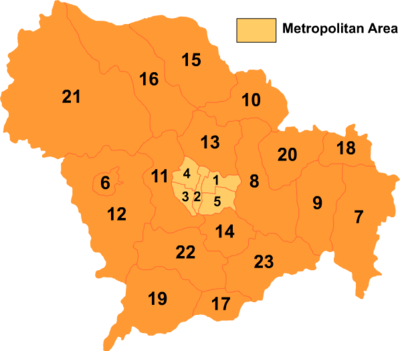 |
||||||
| # | Name | Hanzi | Hanyu Pinyin | Population (2004 est.) | Area (km²) | Density (/km²) |
| 1 | Chang'an District | 长安区 | Cháng'ān Qū | 410,000 | 110 | 3,727 |
| 2 | Qiaodong District | 桥东区 | Qiáodōng Qū | 320,000 | 43 | 7,442 |
| 3 | Qiaoxi District | 桥西区 | Qiáoxī Qū | 450,000 | 53 | 8,491 |
| 4 | Xinhua District | 新华区 | Xīnhuá Qū | 460,000 | 92 | 5,000 |
| 5 | Yuhua District | 裕华区 | Yùhuá Qū | 430,000 | 101 | 4,257 |
| 6 | Jingxing Mining District | 井陉矿区 | Jǐngxíng Kuàngqū | 100,000 | 56 | 1,786 |
| 7 | Xinji City | 辛集市 | Xīnjí Shì | 610,000 | 951 | 641 |
| 8 | Gaocheng City | 藁城市 | Gàochéng Shì | 740,000 | 836 | 885 |
| 9 | Jinzhou City | 晋州市 | Jìnzhōu Shì | 510,000 | 619 | 824 |
| 10 | Xinle City | 新乐市 | Xīnlè Shì | 450,000 | 625 | 720 |
| 11 | Luquan City | 鹿泉市 | Lùquán Shì | 360,000 | 603 | 597 |
| 12 | Jingxing County | 井陉县 | Jǐngxíng Xiàn | 320,000 | 1,381 | 232 |
| 13 | Zhengding County | 正定县 | Zhèngdìng Xiàn | 440,000 | 568 | 775 |
| 14 | Luancheng County | 栾城县 | Luánchéng Xiàn | 320,000 | 347 | 922 |
| 15 | Xingtang County | 行唐县 | Xíngtáng Xiàn | 410,000 | 1,025 | 400 |
| 16 | Lingshou County | 灵寿县 | Língshòu Xiàn | 310,000 | 1,546 | 201 |
| 17 | Gaoyi County | 高邑县 | Gāoyì Xiàn | 180,000 | 222 | 811 |
| 18 | Shenze County | 深泽县 | Shēnzé Xiàn | 250,000 | 296 | 845 |
| 19 | Zanhuang County | 赞皇县 | Zànhuáng Xiàn | 230,000 | 1,210 | 190 |
| 20 | Wuji County | 无极县 | Wújí Xiàn | 480,000 | 524 | 916 |
| 21 | Pingshan County | 平山县 | Píngshān Xiàn | 450,000 | 2,951 | 152 |
| 22 | Yuanshi County | 元氏县 | Yuánshì Xiàn | 390,000 | 849 | 459 |
| 23 | Zhao County | 赵县 | Zhào Xiàn | 560,000 | 714 | 784 |
Economy
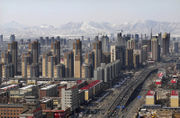
In 2009, the GDP of Shijiazhuang reached RMB 311.7 billion, an increase of 10 percent over the previous year.
Salaries continue to experience relatively rapid growth as well. The city continues to strive to create an economic atmosphere encouraging investment and growth. Total fixed investment reached RMB 172.7 billion.
Shijiazhuang has become a major industrial city in North China and is considered to be the economic center of Hebei province. The city is the largest base for the pharmaceutical industry and is also one of the most important textile industry bases. Other main sectors include machinery and chemicals, building materials, light industry and electronics. With abundant agricultural resources, Shijiazhuang has 590,000 hectares of cultivated land and is the main source of high quality cotton, pears, dates and walnuts in Hebei province.[4]
In 2008, total imports reached US$1.393 billion, an increase of 42.1 percent over the previous year. Exports increased by 34.9 percent to US$5.596 billion.[4]
The Shijiazhuang municipal government reports that higher education and vocational education continue to experience rapid development, while compulsory education has experienced an increase in quality. A 2006 World Bank reports that Shijiazhuang spends less than RMB400 per capita on education, as opposed to Beijing (RMB1,044) and Weihai (RMB1,631).[5]
Development Zones
- Shijiazhuang High-Tech Industrial Development Zone
The zone was established in March 1991 as a State-level development zone and is divided into three districts. Several National Highways like 107, 207, 307, 308 pass through the zone, and it is 15 km away from Shijiazhuang Railway Station, 105 km away from Tianjin Port. The zone has comprehensive infrastructure and industries encouraged include pharmaceuticals, electronic information, mechanical production, automobile manufacturing, chemicals production and logistics.[6]
The Eastern District, located in the eastern part of Shijiazhuang, covers an area of 5.8 square kilometers, and serves as the primary section of the New High-tech Industrial Development Zone. The district focuses on the establishment of new high-tech enterprises. There are plans to expand the district into an area of 9.8 square kilometers. A special railway line operated by Shijiazhuang Oil Refinery runs through the zone from north to south, making it easy for enterprises in the zone to build lines of their own if necessary.[4]
The Western District, located in the southwest of Shijiazhuang, covers an area of 8.2 square kilometers. It focuses on small- and medium-sized technology enterprises and technology incubation. Liangcun District, which borders the Western District, covers four square kilometers, and focuses on the pharmaceutical industry and the petrochemical industry. All three districts are subject to the same policies and regulations.[4]
Since its foundation 2,560 enterprises have settled in the zone, of which 185 are foreign-funded enterprises. At present, firms from Japan, the US, the Republic of Korea, Germany, Italy, Canada, Malaysia, Hong Kong, Macao, and Taiwan have all established themselves in the zone.[5]
Dairy centre
The city is an important centre for the dairy trade, being the headquarters of the Sanlu Group. Both were rocked by the 2008 Chinese milk scandal. Chairman and General Manager of Sanlu, and several party officials, including vice mayor in charge of food and agriculture, Zhang Fawang, were reportedly removed from office.[7][8][9] Mayor Ji Chuntang reportedly resigned on 17 September;[10]
Since Sanlu, the region's largest purchaser of milk, was ordered to halt production, farmers in Hebei are suffering hardship because of the lack of purchasers for their milk. Many are said to be contemplating selling their cows into a buyerless market.[11]
Transportation
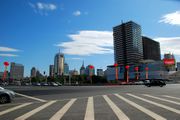

Infrastructure
In 2001 the city received approval from the World Bank for a US$100 million loan for the Shijiazhuang Urban Transport Project, which was designed to foster the development of an efficient and environmentally sustainable urban transport system while providing a wider set of travel choices for users. The project is scheduled to be completed by December 31, 2008, with a total estimated cost of US$266 million. Major elements of the project include the upgrading of 25 kilometers of peripheral roads linking the city to the surrounding provincial highways, the upgrading and construction of 52 kilometers of urban major arterial roads, and the construction of six multi-level interchanges, two major rail overpasses, and 21 pedestrian crossing facilities.[4]
Rail and Roads
Shijiazhuang is a transportation hub: it is at the intersection point of the Beijing-Guangzhou, Taiyuan-Dezhou, and Shuozhou-Huanghua railroads and many expressways, including the Beijing-Shenzhen and Taiyuan-Cangzhou Expressways.
Airport
The Shijiazhuang Zhengding International Airport is the province’s center of air transportation. It is located about 30 kilometers northeast of the city and can accommodate all types of medium and large-sized aircraft. Presently there are 32 domestic routes arriving at and departing from Shijiazhuang, including destinations such as Shanghai, Shenzhen, Dalian, Hong Kong, and other medium and large cities. In addition, the airport services 12 international destinations including four routes to Russia. The airport is currently being expanded and will be capable of being an alternate airport to Beijing Capital International Airport.[5]
Culture
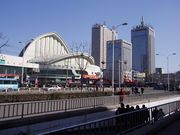

As a young industrial city, Shijiazhuang city proper is generally considered to have relatively few sights of historical or cultural interest. Exceptions are:
- Martyrs' Memorial (Chinese: 烈士陵园; pinyin: Lièshì Língyuán, ) dedicated to Norman Bethune, Eric Liddell, and Dwarkanath Kotnis
- Hebei Museum (Chinese: 河北省博物馆; pinyin: Hébĕi Shĕng Bówùguǎn, )
However, several sites of historical and cultural significance are located in the surrounding area, including:
- Longxing Monastery in Zhengding, 15 kilometers to the north
- Mount Cangyan, 50 km to the southwest
- Zhaozhou Bridge, 40 km to the southeast
- Bailin (Cypress Grove) Temple (Chinese: 柏林禅寺; pinyin: Bǎilín Chán Sì; literally "Cypress Forest Zen Temple", ), 40 km to the southeast, known as one the ten most renowned Buddhist temples in China.
Music
Shijiazhuang is also famous for its rock cultures. Several underground rock bands are active in this city, mostly performing in pubs. Two nation-wide rock magazines, SoRock(我爱摇滚乐) and XMusic (通俗歌曲) are based in Shijiazhuang and act as major platforms promoting rock music in China.
Health
Hospitals
- The First Hospital of Shijiazhuang City[5]
Safety
The Shijiazhuang bombings took place on March 16, 2001 and resulted in 108 deaths and 38 injuries.
Education
Universities and colleges
International relations
Twin towns — Sister cities
Shijiazhuang is twinned with:
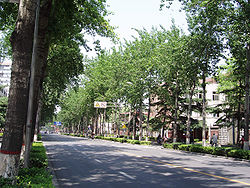
 Saskatoon, Saskatchewan, Canada
Saskatoon, Saskatchewan, Canada Bielsko-Biala, Poland
Bielsko-Biala, Poland Cheonan, South Korea
Cheonan, South Korea Soria, Castilla y León, Spain
Soria, Castilla y León, Spain Falkenberg, Sweden
Falkenberg, Sweden
 Des Moines, Iowa, United States
Des Moines, Iowa, United States
 Edison, New Jersey, United States
Edison, New Jersey, United States Nagykanizsa, Hungary
Nagykanizsa, Hungary
Shijiazhuang also has a Sister City Agreement:
 Bankstown, Australia
Bankstown, Australia
References
- ↑ 1.0 1.1 "China Briefing Business Reports". Asia Briefing. 2009. http://shopping.china-briefing.com/index_eproduct_view.php?products_id=21. Retrieved 2009-02-08.
- ↑ Kenneth Pomeranz (July 22, 2010), Musings on a Museum: A Trip to Xibaipo, http://www.thechinabeat.org/?p=2384
- ↑ 3.0 3.1 "China Meteorological Data Sharing Service System". China Meteorological Administration. http://cdc.cma.gov.cn/shuju/index3.jsp?tpcat=SURF&dsid=SURF_CLI_CHN_MUL_MMON_19712000_CES&pageid=3. Retrieved 2009-09-10.
- ↑ 4.0 4.1 4.2 4.3 4.4 "Dezan Shira & Associates". Dezan Shira & Associates. 2009. http://www.dezshira.com. Retrieved 2009-02-08.
- ↑ 5.0 5.1 5.2 5.3 "China Expat city Guide". China Expat. 2009. http://www.chinaexpat.com/list/102. Retrieved 2009-02-08.
- ↑ RightSite.asia | Shijiazhuang High-Tech Industrial Development Zone
- ↑ Klaudia Lee, "Tests find tainted baby milk at 21 more firms", Page A1, South China Morning Post (17 September 2008)
- ↑ Xinhua, "Officials, company manager sacked following baby milk powder scandal", chinaview.cn (16 September 2008)
- ↑ Lee Spears, China Revokes `Inspection-Free' Right as Milk Scandal Spreads, Bloomberg, (17 September 2008)
- ↑ Death toll rises to four in tainted baby formula scandal in China, Xinhua (18 September 2008)
- ↑ Gillian Wong, China's dairy farmers fret as milk scandal grows, Associated Press (22 September 2008)
External links
- Shijiazhuang Gov website
- Shijiazhuang Urban Network - Shijiazhuang, Hebei's portal
- Shijiazhuang Daily News
- Shijiazhuang blog
|
|||||||
|
|||||||||||||||
|
||||||||||||||||||||||
